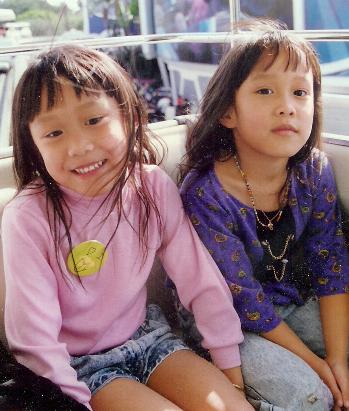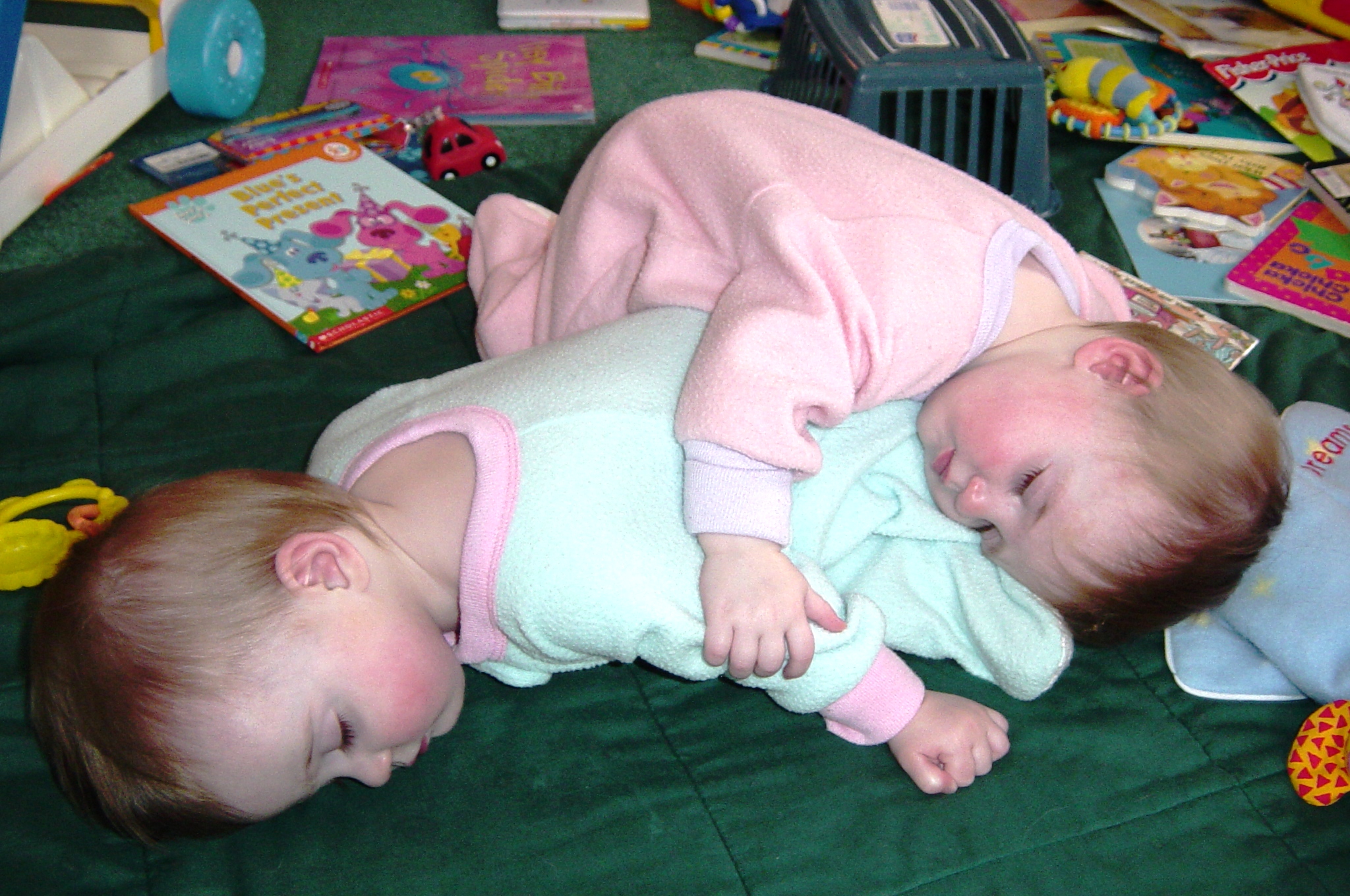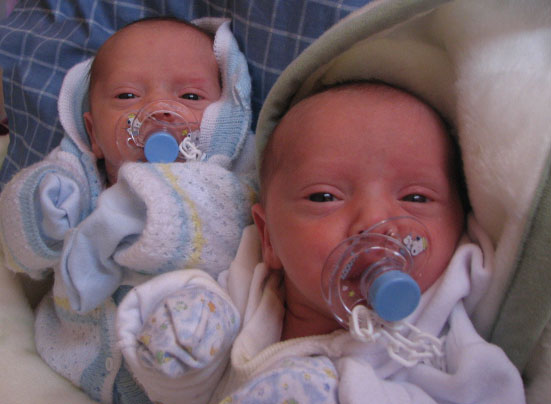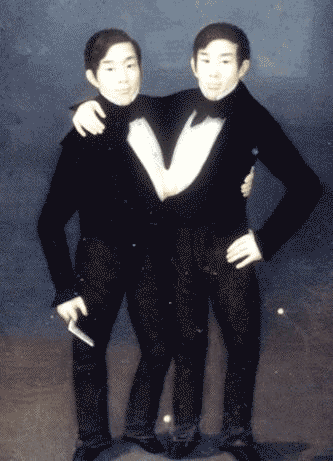Twin
Editor-In-Chief: C. Michael Gibson, M.S., M.D. [3]

Twins are a form of multiple birth in which the mother gives birth to two offspring from the same pregnancy, either of the same or opposite sex.
The general term for more than one offspring from the same pregnancy is multiples, for example triplets refers to cases of three offspring from the same pregnancy. A fetus alone in the womb is called a singleton.
Human twins are two individuals who have shared the uterus during a single pregnancy and are usually, but not necessarily, born in close succession. Due to the limited size of the mother's womb, multiple pregnancies are much less likely to carry to full term than singleton births, with twin pregnancies lasting only 37 weeks on average, 3 weeks less than full term.[citation needed] Since premature births can have health consequences for the babies, twin births are often handled with special precautions.
There are estimated to be approximately 125 million human twins and triplets in the world (roughly 1.9% of the world population), and just 10 million identical twins (roughly 0.2% of the world population and 8% of all twins).[citation needed]
Twins can either be monozygotic or dizygotic.
Types of twins
There are five variations of twinning that commonly occur. The three most common variations are all fraternal: (1) male-female twins are the most common result, at about 40% of all twins born; (2) female fraternal twins (sometimes called sororal twins); (3) male fraternal twins. The last two are identical: (4) female identical twins and (5) (least common) male identical twins. Male singletons are slightly, about 5%, more common than female singletons. However, males are also more susceptible than females to death in utero, and since the death rate in utero is higher for twins, it leads to female twins being more common than male twins.
Another variety of twins, "polar body twins," (one egg fertilized by two different sperm) is a phenomenon that was hypothesized to occur and may recently have been proven to exist. Polar body twinning would result in "half-identical" twins.[1]

Fraternal twins
Fraternal twins (commonly known as "non-identical twins") usually occur when two fertilized eggs are implanted in the uterine wall at the same time. The two eggs form two zygotes, and these twins are therefore also known as dizygotic as well as "biovular" twins. When two eggs are independently fertilized by two different sperm cells, fraternal twins result.
Dizygotic twins, like any other siblings, have an extremely small chance of having the exact same chromosome profile. Like any other siblings, fraternal twins may look very similar, particularly given that they are the same age. However, fraternal twins may also look very different from each other. They may be different sexes or the same sex. The same holds true for brothers and sisters from the same parents, meaning that fraternal twins are simply brothers and/or sisters who happen to have the same age.
Studies show that there is a genetic basis for fraternal twinning. However, it is only the female partner that has any influence on the chances of having fraternal twins as the male cannot make her release more than one ovum. Fraternal twinning ranges from 6 per thousand births in Japan (similar to the rate of identical twins) to 14 and more per thousand in some African states.[citation needed]
Fraternals are also more common for older mothers, with twinning rates doubling in mothers over the age of 35.[citation needed] With the advent of technologies and techniques to assist women in getting pregnant, the rate of fraternals has increased markedly. For example, in New York City's Upper East Side there were 3,707 twin births in 1995; there were 4,153 in 2003; and there were 4,655 in 2004. Triplet births have also risen, from 60 in 1995 to 299 in 2004.
Identical twins

Identical twins occur when a single egg is fertilized to form one zygote (monozygotic) which then divides into two separate embryos. Although their traits and physical appearances are not exactly the same due to environmental conditions both in and outside the womb, they do have identical DNA. This is not considered to be a hereditary trait, but rather an anomaly that occurs in birthing at a rate of about 3 in every 1000 deliveries worldwide,[2] regardless of ethnic background. The two embryos develop into fetuses sharing the same womb. When one egg is fertilized by one sperm cell, and then divides and separates, two identical cells will result. If the zygote splits very early (in the first 2 days after fertilization) they may develop separate placentas (chorion) and separate sacs (amnion). These are called dichorionic, diamniotic (or "di/di") twins, which occurs 20-30% of the time. Most of the time in identical twins the zygote will split after 2 days, resulting in a shared placenta, but two separate sacs. These are called monochorionic, diamniotic ("mono/di") twins.
In about 1% of identical twins the splitting occurs late enough to result in both a shared placenta and a shared sac called; monochorionic, monoamniotic ("mono/mono") twins. Finally, the zygote may split extremely late, resulting in conjoined twins. Mortality is highest for conjoined twins due to the many complications resulting from shared organs. Mono/mono twins have an overall in-utero mortality of about 60%, principally due to cord entanglement prior to 32 weeks gestation. Many times, monoamniotic twins are delivered at 32 weeks electively for the safety of the babies. In higher order multiples, there can sometimes be a combination of fraternal/identical twins.
Mono/di twins have about a 25% mortality due to twin-twin transfusion. Di/di twins have the lowest mortality risk at about 9%, although that is still significantly higher than that of singletons.[3]
Monozygotic twins are genetically identical (unless there has been a mutation in development) and they are usually the same sex. (On rare occasions, Monozygotic twins may express different phenotypes (normally due to an environmental factor or the deactivation of different X chromosomes in monozygotic female twins), and in some extremely rare cases, due to aneuploidy, twins may express different sexual phenotypes, normally due to an XXY Klinefelter's syndrome zygote splitting unevenly [4] [5]). Monozygotic twins generally look alike. Although they do not have the same fingerprints (which are environmental as well as genetic). As they mature, identical twins often become less alike because of lifestyle choices or external influences. Genetically speaking, the children of identical twins are half-siblings rather than cousins. If each member of one set of identical twins marries one member of another set of identical twins then the resulting children would be genetic full siblings. It is estimated that there are around 10 million identical twins and triplets in the world.
The likelihood of a single fertilisation resulting in identical twins appears to be a random event, not a hereditary trait, and is uniformly distributed in all populations around the world.[citation needed] This is in marked contrast to fraternal twinning which ranges from about 6 per thousand births in Japan (almost similar to the rate of identical twins, which is around 4-5) to 15 and more per thousand in some parts of India[6] (and up to 24 in the US, which might mainly be due to IVF, in vitro fertilisation). The exact cause for the splitting of a zygote or embryo is unknown.
Studies have shown that identical twins reared in different environments share similar personality traits, mannerisms, job choices, attitudes, and interests. These findings add to the belief that many behaviors are derived from genes.[citation needed]
Identical twins have identical DNA but differing environmental influences throughout their lives affect which genes are switched on or off. This is called epigenetic modification. A study of 80 pairs of human twins ranging in age from 3 to 74 showed that the youngest twins have relatively few epigenetic differences. The number of epigenetic differences between identical twins increases with age. 50-year-old twins had over three times the epigenetic difference of 3-year-old twins. Twins who had spent their lives apart (such as those adopted by two different sets of parents at birth) had the greatest difference.[7] However, certain characteristics become more alike as twins age, such as IQ and personality.[8][9] This phenomenon illustrates the influence of genetics in many aspects of human characteristics and behaviour.
A new theory (July 3, 2007) found that identical twins are formed after an embryo essentially collapses, splitting the progenitor cells (those that contain the body's fundamental genetic material) in half. That leaves the same genetic material divided in two on opposite sides of the embryo. Eventually, two separate fetuses develop. The research was presented at a meeting of the European Society for Human Reproduction and Embryology in Lyon, France. Utilizing computer software to take photos every 2 minutes of 33 embryos growing in a laboratory, Dr. Dianna Payne, a visiting research fellow at the Mio Fertility Clinic in Japan, documented for the first time the early days of twin development. Payne also discovered explanation for why in-vitro fertilization techniques are more likely to create twins. Only about 3 pairs of twins per 1,000 deliveries occur as a result of natural conception. But for IVF deliveries, there are nearly 21 pairs of twins for every 1,000.[10]Also, the latest twin study found that ability to listen to 2 things at once is largely inherited. Thus, listening to someone talking, speech entering the right ear travels in large part to the left side of the brain, where language is processed. Speech entering the left ear travels first to the right side of the brain before crossing to the brain's language center on the left side by way of the corpus callosum, a pathway connecting the brain's right and left hemispheres. NIDCD researchers based this finding from studies of identical and fraternal twins (national twins festival in Twinsburg, OH, during the years 2002 through 2005). 194 same-sex pairs of twins participated in the study (138 identical pairs and 56 fraternal pairs), representing ages 12 through 50. Researchers found a significantly higher correlation among identical twins than fraternal twins, indicating that differences in performance for those activities had a strong genetic component. It was found that if a trait is purely genetic, identical twins, who share the same DNA, will be alike nearly 100 percent of the time, while fraternal twins, who share roughly half of their DNA, will be less similar. Conversely, if a trait is primarily due to a person's environment, both identical and fraternal twins should have roughly the same degree of similarity, since most twins grow up in the same household.[11]
Semi-identical
Monozygotic twins can develop differently, due to different genes being activated.[12]. More unusual are "Semi-identical twins". These "half-identical twins" are hypothesized to occur when an unfertilized egg cleaves into two identical attached ova and which are viable for fertilization. Both cloned ova are then fertilized by different sperm and the coalesced eggs undergo further cell duplications developing as a chimeric zygote. If this chimeric blastomere then undergoes a twinning event, two embryos will be formed, each of which is chimeric for the paternal genes (and identical for maternal genes).
This results in a set of twins with identical genes from the mother's side, but different genes from the father's side. Cells in each fetus carry genes from either sperm, resulting in chimeras. This form had been speculated until only recently being recorded in western medicine[13] [14] [15].
Demographics
A recent study found that vegan mothers are five times less likely to have twins than those who eat animal products.[16]
From 1980–97, the number of twin births in the United States rose 52%.[17] This rise can at least partly be attributed to the increasing popularity of fertility drugs like Clomid and procedures like in vitro fertilization, which result in multiple births more frequently than unassisted fertilizations do. It may also be linked to the increase of growth hormones in food.[16]
Ethnicity
About 1 in 90 human births (1.1%) results from a twin pregnancy.[18] The rate of fraternal twinning varies greatly among ethnic groups, ranging as high as about 6% for the Yoruba or 10% for Linha Sao Pedro, a tiny Brazilian village.[19] The widespread use of fertility drugs causing hyperovulation (stimulated release of multiple eggs by the mother) has caused what some call an "epidemic of multiple births". In 2001, for the first time ever in the US, the twinning rate exceeded 3% of all births. Thus, approximately 5.8% of children born in the US in 2001 were twins. Among Hausa of Nigeria and Niger the incidence of multiple births was studied using the maternity records of 5750 Hausa women living in the savannah zone of Nigeria. There were 40 twins and 2 triplets/1000 births. Twenty six per cent of twins were monozygous. The incidence of multiple births, which was about five times higher than that observed in any western population, was significantly lower than that of other ethnic groups, who live in the hot and humid climate of the southern part of country. The incidence of multiple births was related to maternal age but did not bear any association to the climate or prevalence of malaria.[20] Nevertheless, the rate of identical twins remains at about 1 in 333 across the globe, further suggesting that pregnancies resulting in identical twins occur randomly.
Predisposing factors
The cause of monozygotic twinning is unknown.
Dizygotic twin pregnancies are slightly more likely when the following factors are present in the woman:
- She is of West African descent (especially Yoruba or Hausa)[citation needed]
- She is between the age of 30 and 40 years
- She is greater than average height and weight
- She has had several previous pregnancies.
- She has a family history of dizygotic twinning, especially a mother who is a twin.
Women undergoing certain fertility treatments may have a greater chance of dizygotic multiple births. This can vary depending on what types of fertility treatments are used. With in vitro fertilisation (IVF), this is primarily due to the insertion of multiple embryos into the uterus. Some other treatments such as the drug Clomid can stimulate a woman to release multiple eggs, allowing the possibility of multiples. Many fertility treatments have no effect on the likelihood of multiple births.
There is also speculation that the West African predisposition to twinning is due to the large amount of yams in their diet because yams contain phytoestrogens, which may stimulate the ovaries. Most likely this is nothing but a myth, as phytoestrogens would tend to suppress twinning by reducing gonadotropin levels.
Complications of twin pregnancy
Vanishing twins
Researchers suspect that as many as 1 in 8 pregnancies start out as multiples, but only a single fetus is brought to full term, because the other has died very early in the pregnancy and not been detected or recorded. Early obstetric ultrasonography exams sometimes reveal an "extra" fetus, which fails to develop and instead disintegrates and vanishes. This is known as vanishing twin syndrome.

Conjoined twins
Conjoined twins (or "Siamese twins") are monozygotic twins whose bodies are joined together at birth. This occurs where the single zygote of identical twins fails to separate completely, and the zygote starts to split after day 13 following fertilization. This condition occurs in about 1 in 50,000 human pregnancies. Most conjoined twins are now evaluated for surgery to attempt to separate them into separate functional bodies. The degree of difficulty rises if a vital organ or structure is shared between twins, such as brain, heart or liver.
Chimerism
A chimera is an ordinary person or animal except that some of his or her parts actually came from his or her twin or from the mother. A chimera may arise either from identical twin fetuses (where it would be impossible to detect), or from dizygotic fetuses, which can be identified by chromosomal comparisons from various parts of the body. The number of cells derived from each fetus can vary from one part of the body to another, and often leads to characteristic mosaicism skin colouration in human chimeras. A chimera may be a hermaphrodite, composed of cells from a male twin and a female twin.
Parasitic twins
Sometimes one twin fetus will fail to develop completely and continue to cause problems for its surviving twin. One fetus acts as a parasite towards the other.
Sometimes the parasitic twin becomes an almost indistinguishable part of the other.
Partial molar twins
A very rare type of parasitic twinning is where a single viable twin is endangered when the other zygote becomes cancerous, or molar. This means that the molar zygote's cellular division continues unchecked, resulting in a cancerous growth that overtakes the viable fetus. Typically, this results when one twin has either triploidy or complete paternal uniparental disomy, resulting in little or no fetus and a cancerous, overgrown placenta, resembling a bunch of grapes.
Miscarried twin
Occasionally, a woman will suffer a miscarriage early in pregnancy, yet the pregnancy will continue; one twin was miscarried but the other was able to be carried to term. This occurrence is similar to the vanishing twin syndrome.
Low birth weight
Twins typically suffer from the lower birth weights and greater likelihood of prematurity that is more commonly associated with the higher multiple pregnancies. Throughout their lives twins tend to be smaller than singletons on average.
Twin-to-twin transfusion syndrome
Identical twins who share a placenta can develop twin-to-twin transfusion syndrome. This condition means that blood from one twin is being diverted into the other twin. One twin, the 'donor' twin, is small and anemic, the other, the 'recipient' twin, is large and polycythemic. The lives of both twins are endangered by this condition.
Human twin studies
Twin studies are studies that assess identical (monozygotic) twins for medical, genetic, or psychological characteristics to try to isolate genetic influence from environmental influence. Twins that have been separated early in life and raised in separate households are especially sought-after for these studies, which have been invaluable in the exploration of human nature.
Unusual twinnings
There are some patterns of twinning that are exceedingly rare: while they have been reported to happen, they are so unusual that most obstetricians or midwives may go their entire careers without encountering a single case.
Among fraternal twins, in rare cases, the eggs are fertilized at different times with two or more acts of sexual intercourse, either within one menstrual cycle (superfecundation) or, even more rarely, later on in the pregnancy (superfetation). This can lead to the possibility of a woman carrying fraternal twins with different fathers (that is, half-siblings). This phenomenon is known as heteropaternal superfecundation. One 1992 study estimates that the frequency of heteropaternal superfecundation among dizygotic twins whose parents were involved in paternity suits was approximately 2.4%; see the references section, below, for more details.
Fraternal twins from biracial couples can sometimes be mixed twins - which exhibit differing ethnic and racial features.
Among monozygotic twins, in extremely rare cases, twins have been born with opposite sexes (one male, one female). The probability of this is so vanishingly small (only 3 documented cases[21]) that multiples having different sexes is universally accepted as a sound basis for a clinical determination that in utero multiples are not monozygotic. When monozygotic twins are born with different sexes it is because of chromosomal birth defects. In this case, although the twins did come from the same egg, it is incorrect to refer to them as genetically identical, since they have different karyotypes.
The Largest Annual Gathering of Twins takes place in Twinsburg, Ohio every year on the first full weekend of August. Over three thousand sets of twins typically attend the weekend-long event.[22]
Animal twins
Twins are common in many animal species, such as cats, sheep, ferrets and deer. The incidence of twinning among cattle is about 1-4%, and research is underway to improve the odds of twinning, which can be more profitable for the breeder if complications can be sidestepped or managed. A species of armadillo (Dasypus novemcinctus) has identical twins (usually four babies) as its regular reproduction and not as exceptional cases.[citation needed]
See also
- List of twins
- List of multiple births
- NICU (Neonatal Intensive Care Unit)
- Half twins
- Twinless twins
Notes
- ↑ Kris Bigalk. "Rare Forms of Twinning". bellaonline.com. Retrieved 2007-03-22.
- ↑ April Holladay (2001-05-09). "What triggers twinning?". WonderQuest. Retrieved 2007-03-22.
- ↑ Benirschike K, "Multiple Gestation" in Creasy RK, Resnik R, (eds.) Maternal-Fetal Medicine: Principles and Practice; 5th ed. (2004):55-62. Philedelphia: Saunders.
- ↑ Edwards, J. H., Dent, K., and Kahn,J. Monozygotic twins of different sex. J. Med. Genet. 1966 3: 117-123.
- ↑ Machin, G. A. Some causes of genotypic and phenotypic discordance in monozygotic twin pairs. Amer. J. Med. Genet. 1996 61: 216-228
- ↑ Oleszczuk JJ, Keith DM et al. Projection of Population-based twinning rates through the year 2100. J Reprod Med. 44(11), 1999. 913–921.
- ↑ Fraga, M.; Ballestar, E.; Paz, M.; Ropero, S.; Setien, F.; Ballestar, M.; Heine-Suner, D.; Cigudosa, J.; Urioste, M.; Benitez, J.; Boix-Chornet, M.; Sanchez-Aguilera, A.; Ling, C.; Carlsson, E.; Poulsen, P.; Vaag, A.; Stephan, Z.; Spector, T.; Wu, Y.; Plass, C.; Esteller, M. (2005), "Epigenetic differences arise during the lifetime of monozygotic twins", Proceedings of the National Academy of Sciences, 102 (30): 10413–10414 Unknown parameter
|author9 link=ignored (help) - ↑ Segal, K. Entwined Lives: Twins and What They Tell Us About Human Behavior, Plume Publishing, 2002
- ↑ DeFries, J. McGuffin, P., McClearn, G., Plomin, R., Behavioural Genetics, Worth Publishers, 4th Edition, 2000
- ↑ Associated Press. "Study: Twins form after embryo collapses". Retrieved 2007-07-03.
- ↑ Dr. Priya Saxena. "Ability to listen to 2 things at once is largely inherited, says twin study". Retrieved 2007-07-16.
- ↑ Non-identical Monozygotic Twins
- ↑ Vivienne L. Souter, Melissa A. Parisi, Dale R. Nyholt, Raj P. Kapur, Anjali K. Henders, Kent E. Opheim, Daniel F. Gunther, Michael E. Mitchell, Ian A. Glass and Grant W. Montgomery, A case of true hermaphroditism reveals an unusual mechanism of twinning, Human Genetics journal (Vol 121, No 2, pp179-185), April 2007; ISSN 0340-6717 (Print), 1432-1203 (Online)
- ↑ Rare Semi-Identical Twins Discovered
- ↑ 'Semi-identical' twins discovered from Nature
- ↑ 16.0 16.1 Vegan moms less likely to have twins
- ↑ National Vital Statistics Reports Vol. 47, No. 24: "Trends in Twin and Triplet Births: 1980-1997" (PDF)
- ↑ Asch, Ricardo (1995). Progress in Reproductive Medicine. Informa Health Care. ISBN 1850705747.
- ↑ U. Matte et al. Study on possible increase in twinning rate at a small village in south Brazil. Acta Genet Med Gemellol (Roma). 45(4), 1996. 431–437.
- ↑ ""MULTIPLE BIRTHS IN HAUSA WOMEN"". "An International Journal of Obstetrics and Gynaecology".
- ↑ [1]
- ↑ [2]
References
- Nieuwint A, Van Zalen-Sprock R, Hummel P, Pals G, Van Vugt J, Van Der Harten H, Heins Y, Madan K. (1999). "'Identical' twins with discordant karyotypes". Prenatal Diagnosis. 19 (1): 72–6. PMID 10073913.
- Wenk RE, Houtz T, Brooks M, Chiafari FA (1992). "How frequent is heteropaternal superfecundation?". Acta geneticae medicae et gemellologiae. 41 (1): 43–7. PMID 1488855.
- Girela E, Lorente JA, Alvarez JC, Rodrigo MD, Lorent M, Villaneuva E (1997). "Indisputable double paternity in dizygous twins". Fertility and Sterility. 67 (6): 1159–61. PMID 9176461.
Further reading
- Schein, E., Bernstein, P. (Random House, 2007). "Identical Strangers: A Memoir of Twins Separated and Reunited."
- Helle, S., Lummaa, V. & Jokela, J. (2004). Selection for increased brood size in pre-industrial humans. Evolution 52: 430-436. Full text
ca:Bessó da:Tvilling de:Zwillinge io:Jemelo id:Kembar it:Gemelli (biologia) he:תאומים ko:쌍둥이 la:Gemini lt:Dvyniai nl:Meerling ms:Kembar no:Tvilling sr:близанац fi:Kaksoset sv:Tvillingar yi:צווילינג
- Pages with citations using unsupported parameters
- All articles with unsourced statements
- Articles with unsourced statements from August 2007
- Articles with invalid date parameter in template
- Articles with unsourced statements from January 2007
- Articles with unsourced statements from February 2007
- Articles with unsourced statements from May 2007
- Articles with unsourced statements from September 2007
- CS1 maint: Multiple names: authors list
- Reproduction